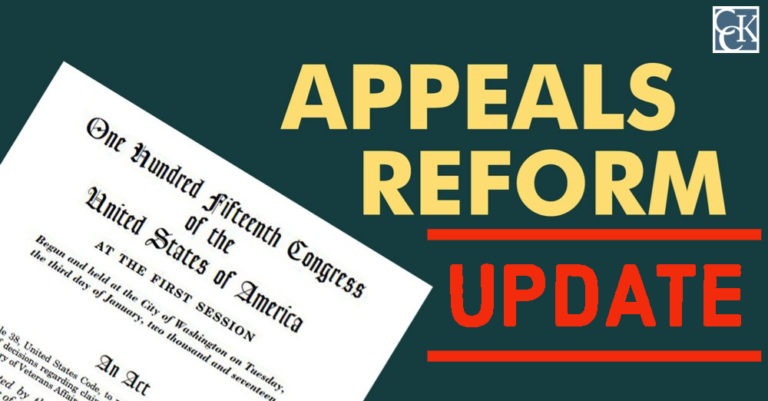RAMP and Appeals Reform Updates

CCK Law: Our Vital Role in Veterans Law
RAMP Statistics
The Rapid Appeals Modernization Program (RAMP) has seen a significant increase in participation since its launch in November 2017, with the national opt-in rate increasing from 3% to 17%. This growth in numbers is likely due to RAMP’s reported timeliness and high levels of productivity in regards to processing decisions. In July of 2018, it took an average of 172 days to receive a decision. One month later in August of 2018, this average was down to 115 days. Currently, in October of 2018, VA indicates that RAMP decisions now take an average of 94 days. In total, the program has produced approximately 22,000 decisions resulting in $94 million in retroactive benefits paid under RAMP. VA attributes RAMP’s success as shown by the above statistics in part due to the addition of two more RAMP Regional Offices. Namely, both Columbia, SC and Oakland, CA have been assigned to handle RAMP cases.
Note: On February 19, 2019 the Veterans Appeals Improvement and Modernization Act (AMA) was officially implemented, thus ending the Rapid Appeals Modernization program. The most up-to-date information on the AMA can be found on our page: Veterans’ Appeals Reform.
Problems with RAMP
While the numbers do seem to reflect positively on RAMP, there remain several problems with the program that pose difficulties for both veterans and veterans’ advocates. Specifically, there tends to be a gap in time from when the RAMP opt-in paperwork is sent to VA and when it gets processed. It can take a substantial amount of time before veterans receive a confirmation letter indicating that their appeals are now pending in RAMP. Furthermore, there have been many problems with VA rejecting veterans’ RAMP opt-in, stating that the appeals to be opted-in were not eligible, when in fact they were eligible. Veterans and/or veterans’ advocates must respond to this rejection by asking the Regional Office to correct it. Although this problem usually gets resolved, it does slow down the process. Additionally, in regards to the decision-making timeframe, there is a question as to whether those statistics are completely accurate. It seems VA might be counting the 94-day average from the date it sends the RAMP confirmation letter rather than the date the opt-in documents are submitted.
Appeals Reform
As of now, RAMP will continue to operate until the start of the full implementation of the Appeals Modernization Act (Appeals Reform), which is scheduled to be completely implemented in February of 2019. However, if Appeals Reform is not certified to be operational in February 2019, RAMP will extend until Appeals Reform is officially certified. Any appeal filed between now and the start of Appeals Reform will go into the Legacy appeals system, unless the veteran specifically opts in to RAMP. Importantly, under Appeals Reform, veterans will have the opportunity to withdraw their Higher-Level Review or Supplemental Claim Lane selection and choose a different lane, as long as they do so within a one-year period and VA has not issued a decision yet. The Board will maintain three separate dockets under Appeals Reform, including: direct, hearing, and evidence only. It is estimated that the direct docket option will result in the quickest decision as it does not involve the submission of new evidence or a hearing. Accordingly, VA has set a 365-day goal for issuing decisions in the direct evidence Board lane. As in the Legacy process, veterans will still be able to request an advance on the Board’s docket under Appeals Reform if they meet the current criteria for doing so.
About the Author
Share this Post
